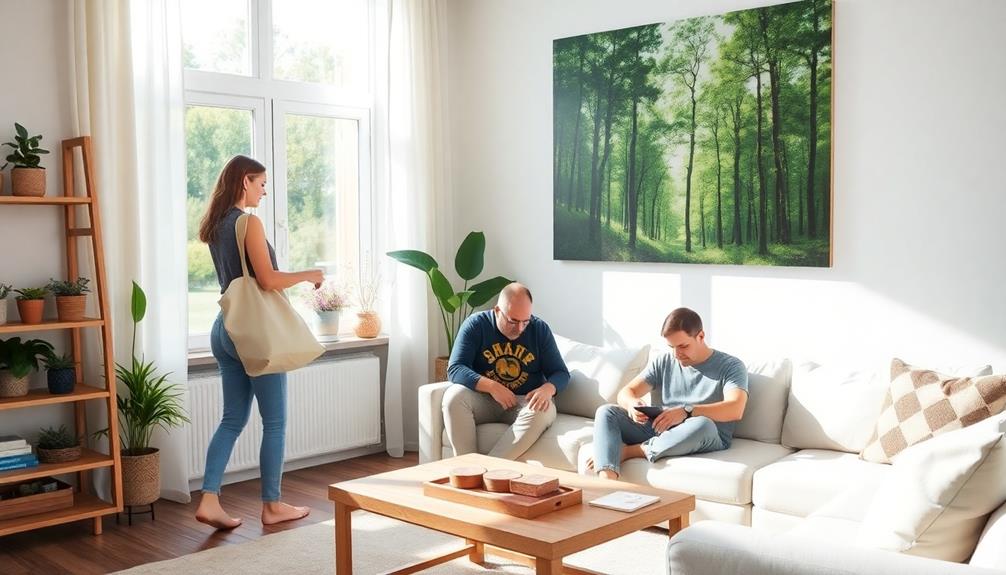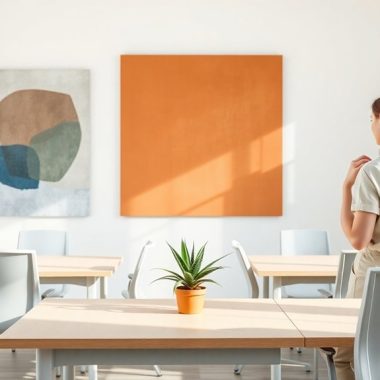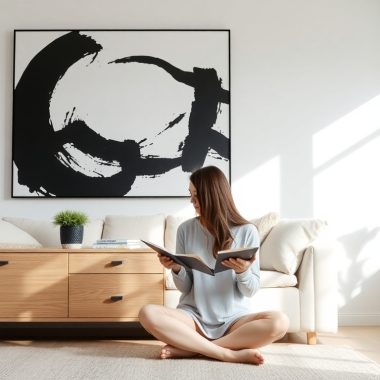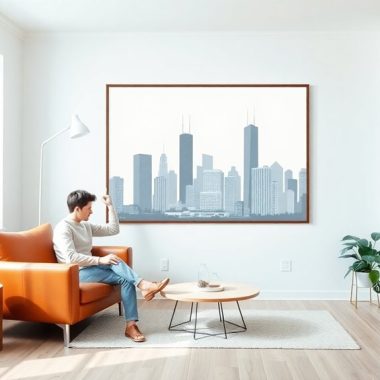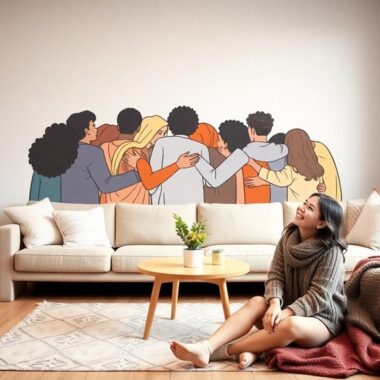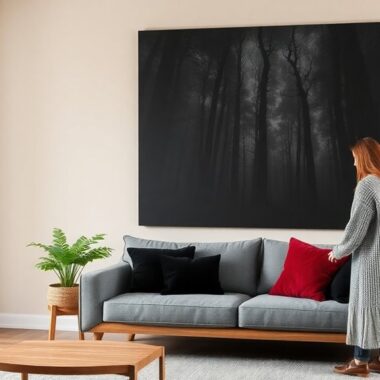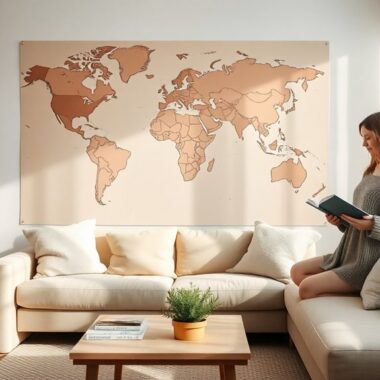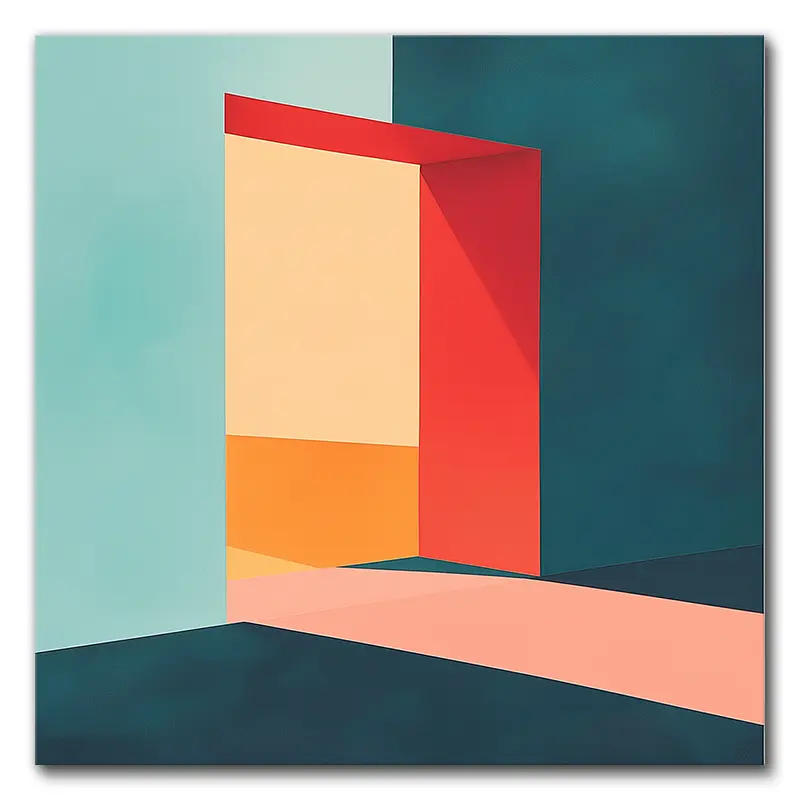Eco-friendly canvas art isn't just a trend; it's a colorful revolution for your home. Utilizing sustainable materials like recycled fabrics, natural pigments, and even reclaimed wood, these artworks not only pique your aesthetic interest but also promote environmental stewardship. Imagine supporting artists who prioritize eco-conscious techniques while you enhance your living space. The market's evolving, with consumers increasingly seeking ethically produced pieces—perhaps your walls could tell a sustainable story. By choosing such art, you're contributing to a circular economy and minimizing pollution. Curious to uncover the fascinating world of DIY projects and market trends? There's plenty more to explore!
Importance of Eco-Friendly Art
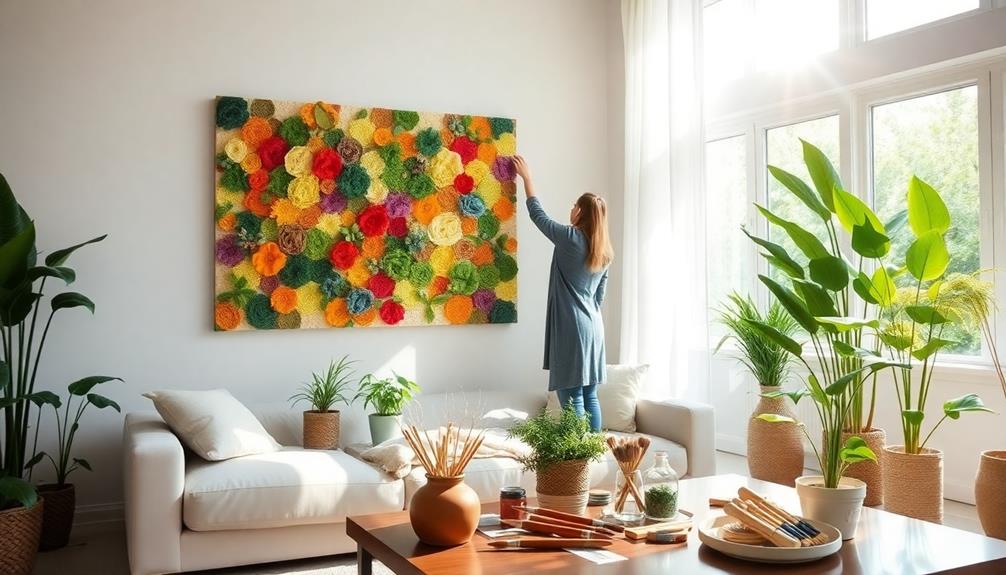
Eco-friendly canvas art plays an essential role in promoting environmental responsibility in the art world. By utilizing sustainable materials like recycled fabrics and natural pigments, these artworks not only reduce pollution but also minimize resource depletion—a win-win for your conscience and the planet.
When you choose eco-friendly canvas art, you're engaging in a larger movement that emphasizes the importance of environmental stewardship, which is becoming increasingly crucial in today's world.
Artists who embrace sustainable canvas art practices aren't just creating beautiful canvas wall art; they're cultivating a deeper connection between creativity and ecological responsibility. This connection fosters a culture where environmental issues become focal points, driving awareness and encouraging thoughtful conversations about our planet's health.
Plus, who doesn't want their living space adorned with a piece that tells a story of sustainability?
The rising consumer demand for sustainable art reflects a notable shift in attitudes. Many folks are now willing to pay a premium for artworks that resonate with their values, which often include a commitment to sustainability.
This trend not only supports artists dedicated to eco-friendly practices but also influences societal norms, merging creativity with environmental consciousness.
Materials and Techniques
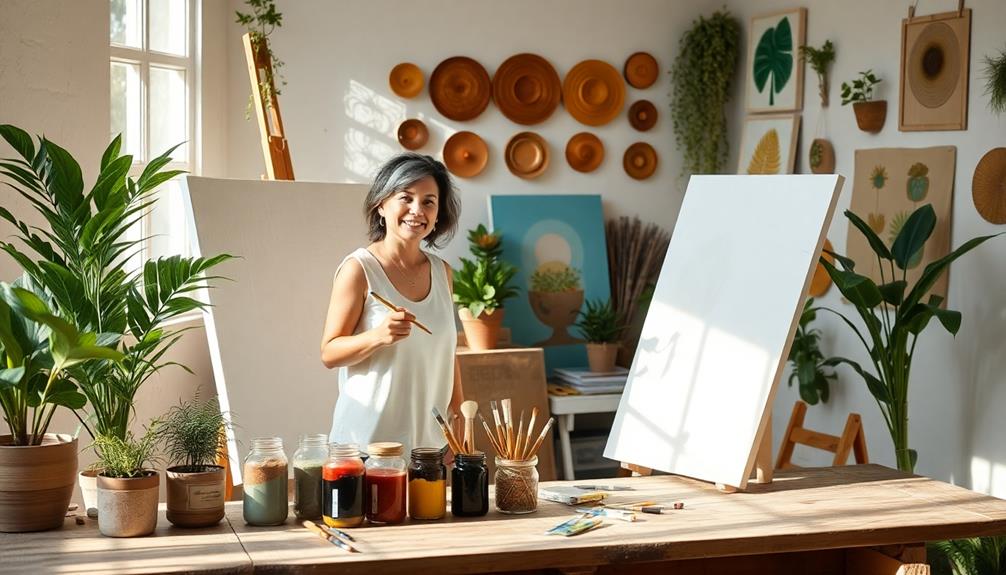
When you're exploring eco-friendly canvas art, the materials and techniques you choose can make a world of difference.
From selecting sustainable material options like recycled canvases to employing eco-friendly painting techniques that use natural pigments, your artistic journey can align with environmental consciousness.
Plus, if you get creative with DIY practices, you might just transform everyday items into stunning works of art, proving that sustainability isn't just smart—it can also be downright fun!
Sustainable Material Options
If you're looking to create art that's kind to the planet, consider using sustainable materials that not only reduce waste but also enhance your creative process. You can explore options like recycled fabrics and 100% recycled plastic bottles, both of which greatly cut down on reliance on new resources. This means fewer landfills and, let's be honest, a happier planet.
Natural pigments and water-based paints offer a vibrant palette while minimizing toxicity—who knew eco-friendly could look so good? Unprimed sustainable canvases made from organic materials provide flexibility, allowing you to release your creativity without the guilt of harming the environment. They come in various sizes, so you're never limited in your artistic ambitions.
Dare to be unconventional! Incorporate reclaimed wood and recycled paper into your pieces. Not only does this diversify your artistic expression, but it also gives new life to materials that might otherwise end up as waste.
And if you're feeling particularly innovative, consider using solar-powered tools; they reflect a commitment to renewable energy, making your artistic process as eco-friendly as the art itself. So, gear up, and let your creativity shine sustainably!
Eco-Friendly Painting Techniques
Creating art sustainably involves embracing innovative painting techniques that prioritize both the environment and your artistic vision. By choosing natural pigments and water-based paints, you greatly reduce toxicity and environmental impact compared to traditional oil-based options. Imagine mixing vibrant colors using plant-based dyes or concocting your very own natural paints from fruits and vegetables—your art could not only be visually stunning but also healthy for the planet.
To give you a clearer picture of these techniques, here's a quick reference table:
| Technique | Benefits |
|---|---|
| Natural Pigments | Lower toxicity, eco-friendly, unique colors |
| Digital Art Tools | Minimal waste, no need for physical materials |
| Solar-Powered Elements | Aesthetic appeal, harnesses renewable energy |
Moreover, repurposing leftover supplies and utilizing recycled or organic canvases not only reduces waste but also encourages a more thoughtful approach to your art-making process. So, as you explore these eco-friendly techniques, remember, each brushstroke can contribute to a healthier planet—one canvas at a time!
DIY Art Practices
Embracing DIY art practices opens up a world of creativity while keeping sustainability at the forefront. By utilizing recycled or organic materials for your canvases, you greatly reduce reliance on new resources, consequently minimizing your environmental impact.
Imagine transforming an old piece of fabric or a forgotten wooden pallet into a stunning work of art!
In your quest for eco-friendly creations, consider natural pigments and water-based paints. These non-toxic options are less harmful, not only to you but also to the planet. You can even create unique dyes and paints from plant-based materials you find nearby, adding a personal touch to your artwork.
Nature truly becomes your palette!
If you're feeling tech-savvy, digital art techniques can help you craft beautiful visuals without the mess of traditional materials, thereby reducing waste.
Plus, don't overlook the joy of repurposing leftover supplies like paper, wood, or fabric; it not only sparks creativity but also fosters a sense of responsibility toward waste reduction.
Market Trends in Sustainable Art
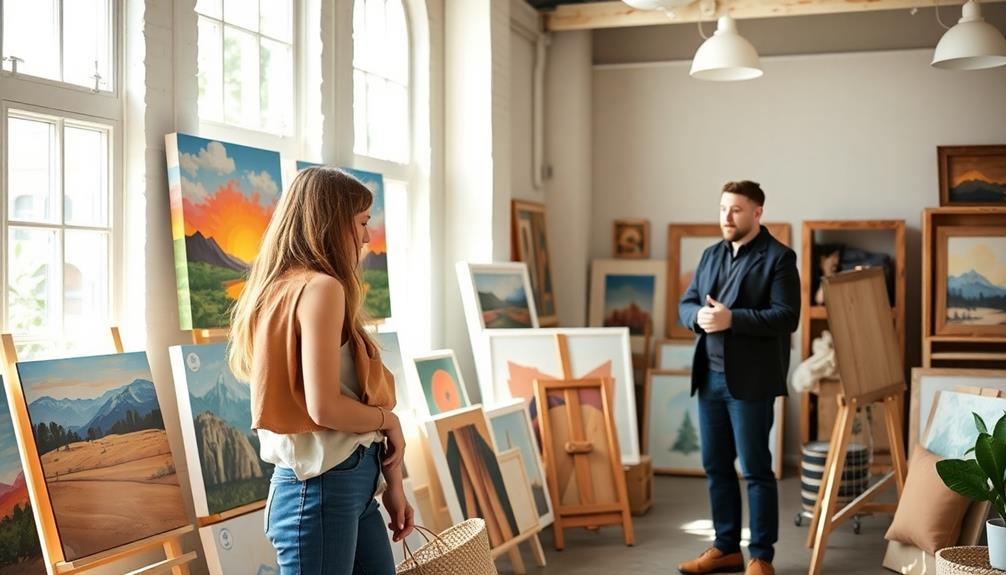
Recognizing the growing demand for eco-friendly canvas art, many artists and galleries are adapting to market trends that prioritize sustainability. You'll find that this shift isn't just a fleeting fad; it's a significant movement fueled by increasing consumer awareness. Younger generations, in particular, are enthusiastic to pay premium prices for art that aligns with their values, creating a fertile ground for eco-friendly creations.
Artists are showcasing their sustainable pieces at exhibitions and art fairs, fostering a community that appreciates both aesthetic value and minimal environmental impact. This burgeoning market is expanding into niche segments, allowing you to discover unique works that resonate with your personal ethos.
Let's break down some key trends:
| Trend | Description |
|---|---|
| Increased Demand | Consumers are actively seeking eco-friendly art. |
| Higher Price Points | Sustainable materials often lead to premium pricing. |
| Niche Market Growth | New segments cater to environmentally conscious collectors. |
Eco-friendly artworks command higher prices, reflecting the ethical materials and processes that artists embrace. As sustainability becomes increasingly woven into the fabric of art practices, you'll notice a shift in market dynamics, prompting a deeper connection between creativity and ecological stewardship. Who knew that hanging a piece of art could contribute to a healthier planet? With each purchase, you're not just decorating your space; you're voting for a greener future, one canvas at a time.
Societal Influence of Eco-Art
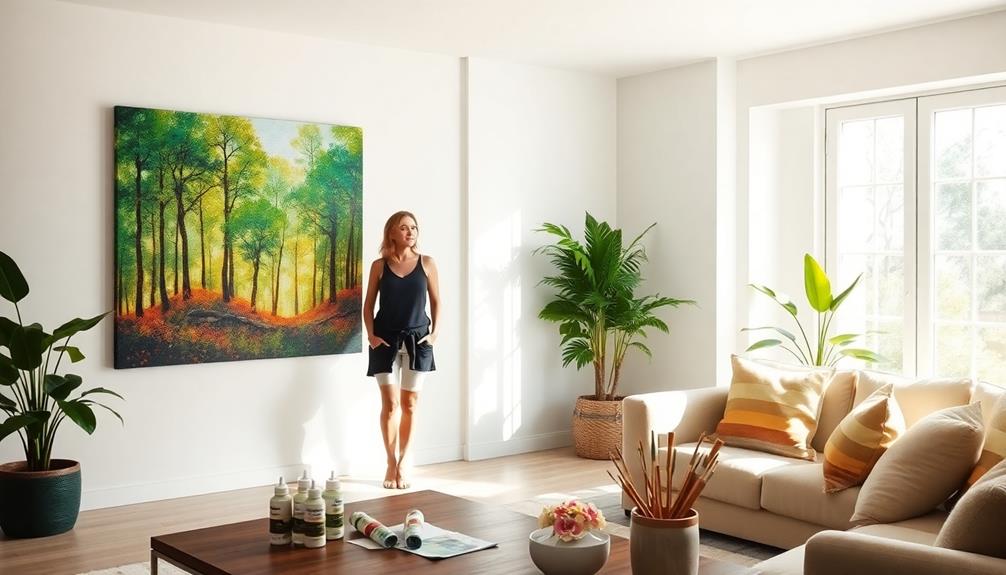
Eco-friendly art markedly shapes societal attitudes towards environmental responsibility, urging both artists and consumers to make sustainable choices. By embracing eco-art, you're not just decorating your space; you're joining a movement that intertwines creativity with ecological awareness. This fusion fosters a deeper connection between art, the environment, and community values, turning mere aesthetics into powerful statements about our planet's future.
Artists, in this scenario, act as ambassadors for change, using their talents to highlight the importance of sustainability. As you explore eco-friendly art, you'll notice that these pieces often serve a dual purpose: they beautify your home while also prompting a dialogue about pressing environmental issues. It's as if each brushstroke whispers a reminder to reflect on our impact on the Earth.
Moreover, the increasing interest in eco-friendly art mirrors a growing consumer demand for sustainable practices. Galleries and artists are now aligning their offerings with this environmental consciousness, creating a cultural paradigm where sustainability takes center stage.
You might find yourself drawn to works that not only appeal to your aesthetic sense but also carry educational messages about climate change and conservation.
In essence, eco-friendly art engages the public in meaningful discussions about our relationship with the environment. It transforms passive spectators into active participants in the quest for sustainability.
Innovations in Eco-Friendly Art

In the domain of modern artistry, innovative approaches are transforming the landscape of eco-friendly art. Artists are embracing sustainable materials, leading to the creation of canvases made entirely from 100% recycled plastic bottles. You might think that sounds like something from a sci-fi movie, but it's very real and surprisingly beautiful. Additionally, natural pigments and water-based paints have surged in popularity, greatly reducing toxicity and environmental impact compared to traditional oil-based paints. This means you can indulge your creativity without the guilt—a artist's dream!
Moreover, digital tools are revolutionizing the art scene by minimizing material waste. With the click of a button, you can create stunning visuals without ever picking up a paintbrush. And let's not forget solar-powered art installations, which cleverly incorporate renewable energy sources, showcasing a fusion of technology and sustainability.
Here's a quick look at some of these innovations:
| Innovation | Description |
|---|---|
| Recycled Plastics Canvases | Canvases made from 100% recycled bottles. |
| Natural Pigments & Paints | Eco-friendly alternatives to traditional paints. |
| Digital Art Tools | Reduce material waste through digital creation. |
| Solar-Powered Installations | Art that harnesses renewable energy. |
Ongoing research into eco-friendly materials promises even more innovative options, enhancing the artistic landscape and promoting environmental responsibility. So, as you explore this fascinating world of eco-art, you might find that every brush stroke really does count!
DIY Eco-Friendly Art Projects
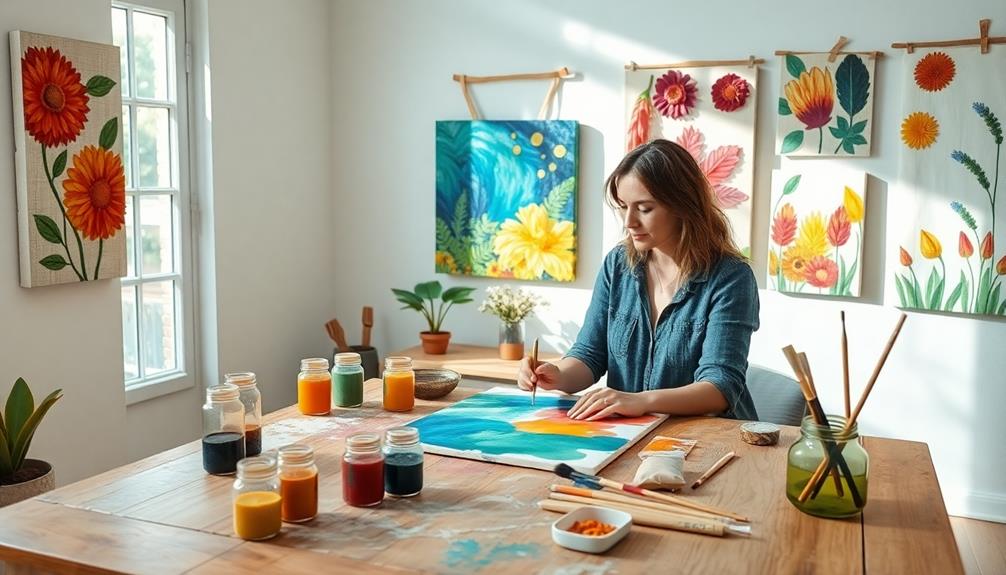
As you explore the world of eco-friendly art, DIY projects offer a hands-on way to express your creativity while making a positive impact on the environment. By utilizing recycled materials like fabric, wood, and paper, you not only minimize reliance on new resources but also reduce waste, transforming what might've ended up in a landfill into stunning pieces of art.
Imagine crafting a vibrant mosaic from old clothes or constructing a whimsical sculpture from discarded wood—each creation tells a story of rebirth. Incorporating techniques from DIY canvas art can enhance your projects, adding unique textures and colors that improve your artistic expression.
You can also experiment with natural dyes and paints derived from plants, which not only add a unique touch to your artwork but also promote sustainable practices. Picture using beet juice for a rich red hue or turmeric for a sunny yellow—your palette could be as vibrant as a garden in full bloom!
Moreover, upcycling discarded objects into sculptures or mosaics can boost your creativity and serve as a statement against wastefulness; who knew that an old bicycle wheel could become a striking wall hanging? Engaging in these projects encourages resourcefulness, allowing you to repurpose leftover art supplies and fostering a mindful approach to material use.
For those looking to innovate further, consider incorporating solar-powered elements into your DIY art. Imagine a mobile that gently spins in the breeze, powered by renewable energy, harmonizing beauty with eco-consciousness.
Environmental Benefits of Sustainable Art

Sustainability in art offers a powerful way to combat environmental challenges while enriching the creative process. By choosing eco-friendly canvas art, you're not just adding a splash of color to your walls; you're also contributing to a healthier planet. For instance, artists are now using recycled materials, including 100% recycled plastic bottles, to produce canvases. This innovation not only diverts plastic from landfills and oceans but also sparks creativity through resourcefulness.
Moreover, the use of non-toxic inks and water-based paints minimizes harmful chemicals, thereby enhancing indoor air quality—a win for households, particularly those with children. Sustainable art practices promote a circular economy by encouraging the use of reclaimed and upcycled materials, reducing the need for new resource extraction.
Curiously enough, as eco-friendly art gains popularity, it fosters a culture of environmental stewardship among artists. The increasing demand for such art reflects a societal shift toward environmental responsibility; you might find yourself more willing to invest in pieces that align with your values.
Here's a quick look at the environmental benefits of sustainable art:
| Benefit | Description | Impact |
|---|---|---|
| Reduces Pollution | Utilizes recycled materials to minimize waste. | Decreases landfill and ocean plastic. |
| Improves Air Quality | Non-toxic inks and paints enhance indoor air. | Safer living spaces for families. |
| Promotes Circular Economy | Encourages reclaimed and upcycled materials. | Conserves natural resources. |
| Fosters Environmental Stewardship | Artists adopt sustainable practices. | Reduces ecological footprints. |
| Reflects Societal Shift | Consumers prefer eco-friendly art. | Supports ethical consumption. |
Supporting Eco-Conscious Artists
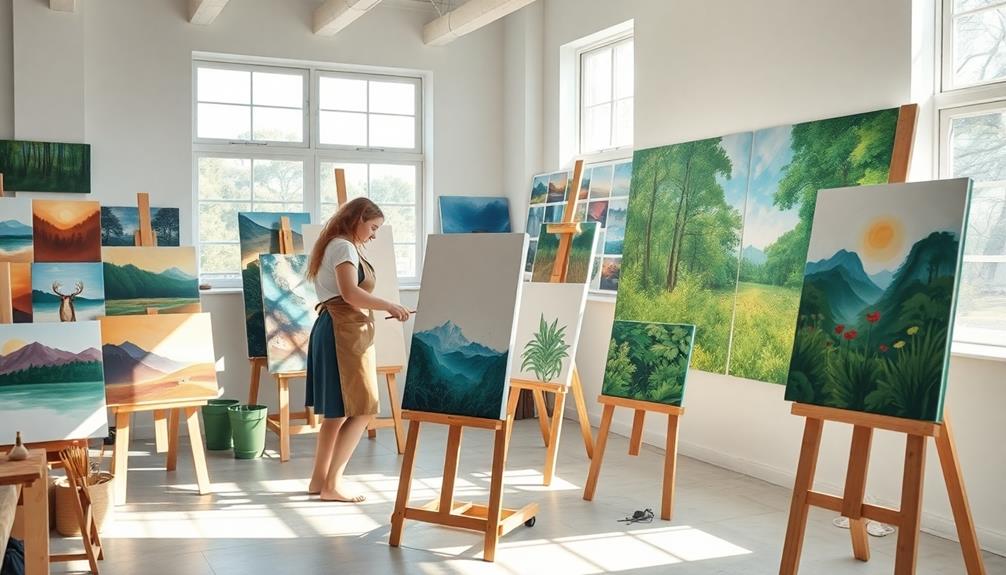
When you support eco-conscious artists, you're not just buying a piece of art; you're empowering creators who prioritize sustainable practices and ethical materials.
These artists often use recycled fabrics and natural pigments, which means your purchase could help reduce plastic waste while brightening your walls.
Plus, who wouldn't want to explain to their friends that their new canvas isn't only stylish but also a nod to greener living?
Empowering Sustainable Creators
Supporting eco-conscious artists not only enriches your collection but also champions a movement that prioritizes the planet. When you invest in the work of sustainable creators, you're not just buying art; you're contributing to an eco-friendly future.
These artists often utilize sustainable materials and innovative techniques, which can lead to a fascinating array of artwork. Here are some key reasons why supporting these creators matters:
- Sustainable Materials: Many eco-conscious artists use recycled fabrics and natural pigments, considerably reducing their environmental impact.
- Niche Market Promotion: Your purchase encourages a market that values sustainability, pushing other artists to adopt responsible practices.
- Waste Minimization: Innovative techniques like digital art and upcycling help artists minimize waste while enhancing their creativity.
- Community Engagement: By connecting with eco-friendly artists, you foster a community that raises awareness about the ecological implications of art.
Ethical Art Practices
Art has the power to inspire change, and ethical art practices play an essential role in that transformation. When you support eco-conscious artists by purchasing their works, you're not just acquiring a piece of art; you're actively participating in a movement that champions sustainability.
Many of these artists harness the power of recycled materials, turning 100% recycled plastic bottles into canvases, which not only reduces waste but also promotes circular economies—who knew trash could be so chic?
Moreover, eco-friendly artists often opt for natural pigments and non-toxic paints, ensuring their creative processes align with health and safety guidelines, thereby minimizing harmful environmental impacts.
As a consumer, you'll find that more people are gravitating toward art that reflects ethical practices, with many willing to invest in sustainable pieces. This trend encourages even more artists to adopt eco-friendly methods—talk about a win-win situation!
Frequently Asked Questions
What Can I Use Instead of Canvas Sustainability?
You can use recycled paper, bamboo fiber, reclaimed wood, or natural fabrics like organic cotton. Incorporating upcycled materials also adds creativity while promoting sustainability, allowing you to create unique art without harming the environment.
Is Canvas Environmentally Friendly?
You can't have your cake and eat it too. While traditional canvas can harm the environment, eco-friendly options use recycled materials and non-toxic inks, making them a sustainable choice that benefits both you and the planet.
What Are the Most Environmentally Friendly Art Supplies?
When you're choosing art supplies, opt for recyclable papers, 100% recycled canvases, water-based inks, and plant-based paints. Reclaimed wood frames and bamboo fiber also provide sustainable options, ensuring your creativity doesn't harm the environment.
What Art Paint Is Environmentally Friendly?
When choosing art paint, look for water-based options free from harmful chemicals and VOCs. Natural pigments and non-toxic ingredients guarantee safety for your home, especially if you've got kids or pets running around.
Final Thoughts
In choosing eco-friendly canvas art, you're not just decorating your space; you're making a statement about sustainability, supporting innovative artists, and embracing a lifestyle that values our planet. By selecting materials that are sustainable, exploring DIY projects that spark your creativity, and staying informed about market trends, you participate in a vibrant community that celebrates both art and environmental responsibility. At VerVeLush, we specialize in high-quality canvas prints that reflect these values, offering a curated selection of eco-conscious art that will adorn your walls beautifully. So, inspire your friends and contribute to a greener world—one canvas at a time, with VerVeLush as your trusted source for sustainable artistry.

